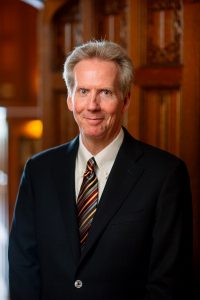Eric Edell, M.D. (THD ’88)
Past President, Board Member
(originally published in 2015)
Division of Pulmonary and Critical Care Medicine
Professor of Medicine
The Connor Group Professor of Thoracic Diseases Honoring Claude Deschamps, M.D., and Eric S. Edell, M.D.
Mayo Clinic Rochester
“Mayo Clinic offered an integrated practice that enabled a simple Kansas boy to develop a world-class practice and still be home for dinner.”
- Fellowship: Thoracic Diseases, Mayo Clinic School of Graduate Medical Education
- Residency: Internal Medicine, Saint Luke’s Hospital of Kansas City, Missouri
- Medical School: University of Kansas School of Medicine, Kansas City
- Undergraduate: University of Kansas, Lawrence
- Native of: Smith Center, Kansas
Why did you decide to pursue medicine?
I’ve always been attracted to helping people. I was involved in Scouting from a young age and took on leadership roles, including tending to Scouts who got sick on camping trips. I was on a swim team with my sister when I was 16, and she had an epileptic seizure in the deep end of the pool. I gave her CPR.
I was from a small town and went to college in a big city. The first year, my GPA wasn’t good, so I set myself a goal to get into medical school. That set me on the right course.
Why did you train at Mayo Clinic?
I became interested in pulmonary and critical care medicine as a subspecialty during my residency. I met an alumnus in that field and asked him to write a letter recommending me for a fellowship. When I went to Mayo Clinic I had no intention of staying. My wife and I are both from Kansas, and we planned to return there. I planned to join a big hospital in Kansas City.
Then my wife met a woman whose husband worked in that hospital practice. She told my wife about a family drawing their son made in school. The drawing didn’t show the father. When asked why, the boy said, “He’s probably working.” My wife shared the story. I promised her that if we stayed at Mayo Clinic, I’d be home for dinner every night. Mayo Clinic offered an integrated practice that enabled a simple Kansas boy to develop a world-class practice and still be home for dinner.
What valuable lesson have you learned at Mayo Clinic?
Practicing in a team of experts provides the best care because the members make each other better for the sake of the patient.
Mayo Clinic’s pyramid is configured correctly, with the patient at the top and research and education as a foundation to improve patient care.
In Latin doctor means teacher. It’s our job to teach patients what they need to know so they can take control of their health rather than us prescribing or telling them what to do. This takes more time and humility, but it’s more effective, I think.
What do you contribute to the Mayo Clinic Alumni Association?
My career is oriented around how to preserve the team-based system that allows doctors to practice in the way described in the Mayo Model of Care. Whenever I meet external alumni, they talk about those principles. I try to reconnect with alumni, and reconnect them to Mayo.
What do you do in your spare time?
My wife and I like to visit New Mexico. I enjoy the outdoors and fishing and hunting, and spending time with family and friends.
What would people be surprised to know about you?
I’ve born a bolo tie every Friday for the last two years. I had a patient from Wyoming who made a big impact on me. His prognosis was to live for three years, but he lived for 15. He and his wife were raising their two grandchildren, and he wanted to be there for them. He overcame more physical challenges than anyone I’ve seen in my practice. He was a cowboy. One day I visited him in the ICU in my cowboy-best bolo tie, and he sat up and gave me a big bear hug. Shortly thereafter he decided to turn off his ventilator, and he died. I connected with his spirit and respected his fight. I told his wife I’d celebrate his life by wearing bolo ties.
